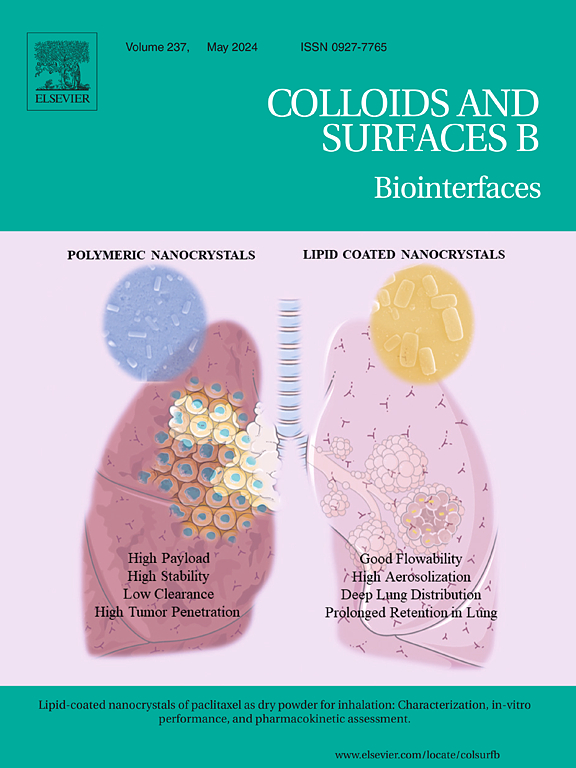Dual-responsive zwitterionic nanogels with synergistic charge reversal and hypoxia-activated drug release for precise tumor targeting and enhanced chemotherapy
IF 5.4
2区 医学
Q1 BIOPHYSICS
引用次数: 0
Abstract
Developing nanomedicine delivery systems that respond to endogenous stimuli from the tumor microenvironment for the precise tumor targeting and controlled release of chemotherapeutic drugs has become a promising candidate to enhance cancer therapy. Here, we designed a zwitterionic nanogel system (named PMm) with charge-switchable and hypoxia-responsive properties for tumor targeting and on-demand drug release. PMm was synthesized through precipitation polymerization, strategically integrating a sulfamide-quaternary ammonium zwitterionic monomer (MPTA) and an azobenzene (azo) based crosslinker (MEFA). In the weakly acidic tumor microenvironment, PMm@DOX nanogels underwent a rapid surface charge reversal (to positive) via protonation of imine moieties, promoting deep tumor penetration and cellular uptake. Following cellular internalization, hypoxia-activated cleavage of the MEFA crosslinker induced the nanogel disassembly and DOX release, leading to the apoptosis of tumor cells. In vitro and in vivo studies demonstrated this dual-responsive nanogel platform synergistically integrated charge-driven targeting and hypoxia-triggered drug release, overcoming the limitations of conventional nanocarriers, enhancing tumor accumulation and showing superior antitumor efficacy. By intelligent surface engineering and microenvironmental responsiveness, the PMm@DOX system represents a promising strategy to amplify chemotherapeutic efficacy while minimizing off-target toxicity.
具有协同电荷逆转和缺氧激活药物释放的双响应两性离子纳米凝胶用于精确肿瘤靶向和增强化疗
开发响应肿瘤微环境内源性刺激的纳米药物递送系统,以精确靶向肿瘤并控制化疗药物的释放,已成为加强癌症治疗的有希望的候选药物。在这里,我们设计了一种两性离子纳米凝胶系统(命名为PMm),具有电荷可切换和缺氧响应特性,用于肿瘤靶向和按需药物释放。采用沉淀聚合法制备了氨基酰胺-季铵两性离子单体(MPTA)和偶氮苯(MEFA)交联剂。在弱酸性肿瘤微环境中,PMm@DOX纳米凝胶通过亚胺部分的质子化,经历了快速的表面电荷反转(变为正电荷),促进了肿瘤的深层渗透和细胞摄取。在细胞内化后,缺氧激活的MEFA交联剂裂解诱导纳米凝胶分解和DOX释放,导致肿瘤细胞凋亡。体外和体内研究表明,该双响应纳米凝胶平台协同整合了电荷驱动靶向和缺氧触发药物释放,克服了传统纳米载体的局限性,促进了肿瘤的积累,显示出优越的抗肿瘤功效。通过智能表面工程和微环境响应,PMm@DOX系统代表了一个有前途的策略,以扩大化疗疗效,同时最大限度地减少脱靶毒性。
本文章由计算机程序翻译,如有差异,请以英文原文为准。
求助全文
约1分钟内获得全文
求助全文
来源期刊

Colloids and Surfaces B: Biointerfaces
生物-材料科学:生物材料
CiteScore
11.10
自引率
3.40%
发文量
730
审稿时长
42 days
期刊介绍:
Colloids and Surfaces B: Biointerfaces is an international journal devoted to fundamental and applied research on colloid and interfacial phenomena in relation to systems of biological origin, having particular relevance to the medical, pharmaceutical, biotechnological, food and cosmetic fields.
Submissions that: (1) deal solely with biological phenomena and do not describe the physico-chemical or colloid-chemical background and/or mechanism of the phenomena, and (2) deal solely with colloid/interfacial phenomena and do not have appropriate biological content or relevance, are outside the scope of the journal and will not be considered for publication.
The journal publishes regular research papers, reviews, short communications and invited perspective articles, called BioInterface Perspectives. The BioInterface Perspective provide researchers the opportunity to review their own work, as well as provide insight into the work of others that inspired and influenced the author. Regular articles should have a maximum total length of 6,000 words. In addition, a (combined) maximum of 8 normal-sized figures and/or tables is allowed (so for instance 3 tables and 5 figures). For multiple-panel figures each set of two panels equates to one figure. Short communications should not exceed half of the above. It is required to give on the article cover page a short statistical summary of the article listing the total number of words and tables/figures.
 求助内容:
求助内容: 应助结果提醒方式:
应助结果提醒方式:


